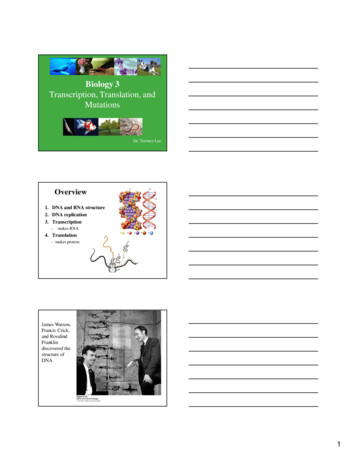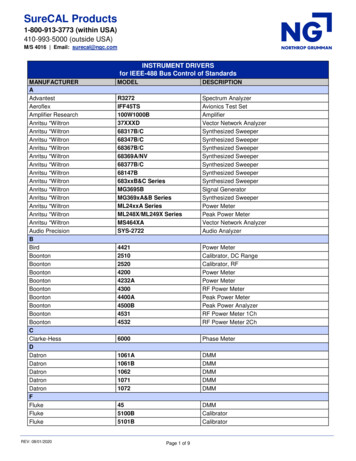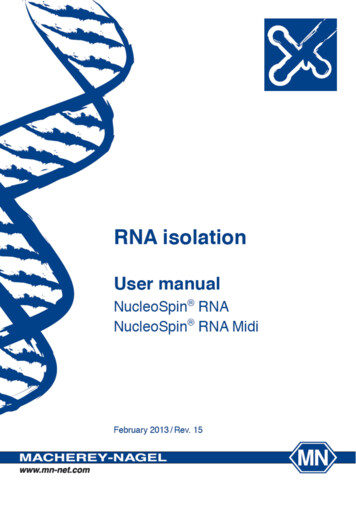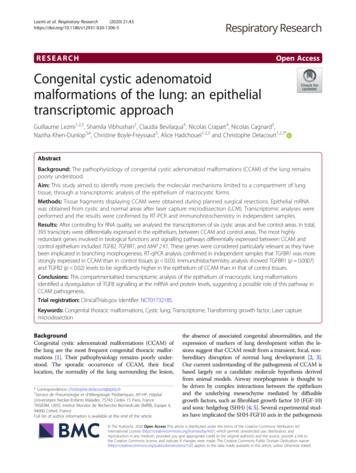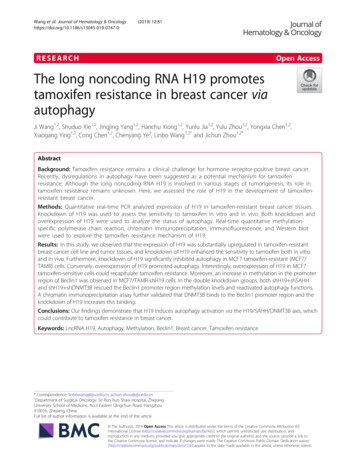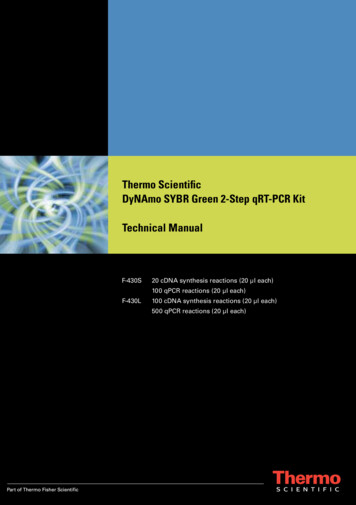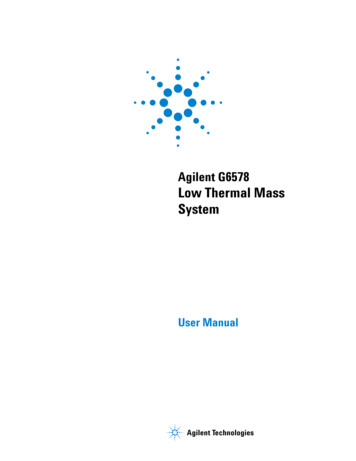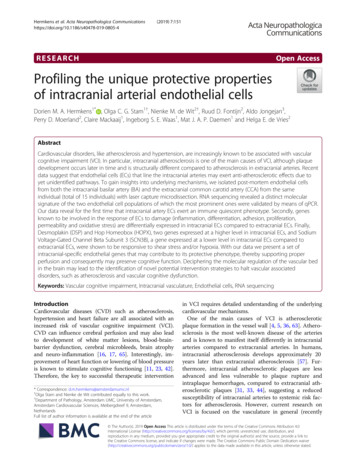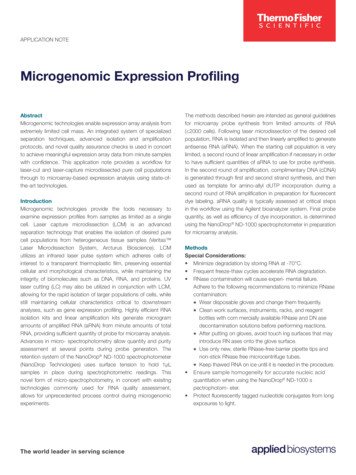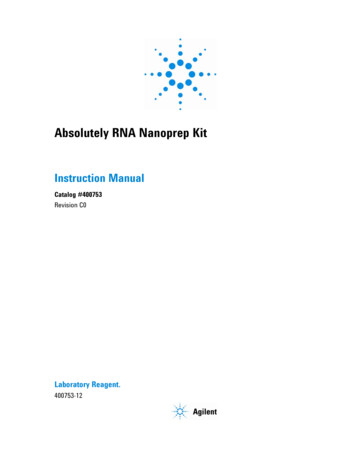
Transcription
Absolutely RNA Nanoprep KitInstruction ManualCatalog #400753Revision C0Laboratory Reagent.400753-12
LIMITED PRODUCT WARRANTYThis warranty limits our liability to replacement of this product. No other warranties of any kind, expressor implied, including without limitation, implied warranties of merchantability or fitness for a particularpurpose, are provided by Agilent. Agilent shall have no liability for any direct, indirect, consequential, orincidental damages arising out of the use, the results of use, or the inability to use this product.ORDERING INFORMATIONPlease visit www.agilent.com.TECHNICAL SERVICESUnited States and CanadaEmail: techservices@agilent.comTelephone: 800 227 9770 (option 3,4,3)All Other LocationsPlease visit www.agilent.com/en/contact-us/page.
Absolutely RNA Nanoprep KitCONTENTSMaterials Provided . 1Storage Conditions . 1Additional Materials Required . 1Introduction . 2Preparing the Reagents. 380% Sulfolane . 3RNase-Free DNase I . 3High-Salt Wash Buffer . 3Low-Salt Wash Buffer . 3 -Mercaptoethanol . 3Protocol . 4RNA Isolation from Cells . 4Expected RNA Yields and Quantification. 6Troubleshooting . 7Appendix I: Isolating RNA from Cells Harvested by Laser Capture Microdissection . 7Appendix II: Preventing Sample Contamination . 8Preventing RNase Contamination . 8Sterilizing Labware . 8Treating Solutions with DEPC . 9Preventing Nucleic Acid Contamination . 9References . 10MSDS Information . 10Quick-Reference Protocol . 11
Absolutely RNA Nanoprep KitMATERIALS PROVIDEDMaterials providedQuantityaLysis Buffer35 ml -Mercaptoethanol ( -ME, 14.2 M)bRNase-Free DNase I (lyophilized)c300 l2600 UDNase Reconstitution Buffer300 lDNase Digestion Buffer1.5 mlHigh-Salt Wash Buffer (1.67 )24 mlLow-Salt Wash Buffer (5 )17 mlElution Buffer (10 mM Tris-HCl, pH 7.5)3 mlRNA-binding nano-spin cups and caps2-ml collection tubes (capless)abc50 each100Sufficient reagents are provided to isolate total RNA from 50 samples of 1–104 cells each.Once opened, store at 4 C.Once reconstituted, store at –20 C.STORAGE CONDITIONSUpon Receipt: Store all components at room temperature. -Mercaptoethanol: Once opened, store at 4 C.RNase-Free DNase I: Once reconstituted, store at –20 C.All Other Components: Once prepared, store at room temperature.CautionGuanidine thiocyanate in the Lysis Buffer and High-Salt Wash Buffer is an irritant.ADDITIONAL MATERIALS REQUIREDSulfolane [Sigma (Catalog #T22209)]EthanolDiethylpyrocarbonate (DEPC)Revision C0Absolutely RNA Nanoprep Kit Agilent Technologies, Inc. 2007-2015, 20201
INTRODUCTIONThe Absolutely RNA nanoprep kit allows rapid purification of high-qualitytotal RNA from extremely small samples of cultured cells(1–104 cells) or cells harvested by laser capture microdissection (LCM).1The unique design of the RNA-binding spin cups provided with theAbsolutely RNA nanoprep kit allows sample recovery in a very smallvolume (10 l), allowing the use of the entire sample in downstreamapplications without further concentration steps that may lead to degradationof the RNA.The nanoprep RNA purification method is outlined in Figure 1. The methodemploys a lysis buffer that contains the chaotropic salt guanidinethiocyanate, a strong protein denaturant, to lyse cells and prevent RNAdegradation by ribonucleases (RNases).2 Following cell lysis, the sample istransferred to a nano-spin cup where the RNA binds to a silica-based fibermatrix.3 An optional DNase digestion removes contaminating DNA, then aseries of washes removes the DNase and other proteins. Highly pure RNA iseluted from the fiber matrix in a low-ionic-strength buffer and is captured ina microcentrifuge tube. The resulting RNA is suitable for use in a multitudeof molecular biology applications, including cDNA synthesis, qualitativeand quantitative RT-PCR, microarray target preparation, northern blottingand differential display.RNA N anoprep MethodLyse cells in Lysis BufferMix lysate with sulfolaneCapture RNA onto fiber matrixSPINSPINTreat with DNase (optional)Wash with High Salt BufferWash twice with Low Salt BufferElute pure RNAin 10 l volumeSPINSPINFIGURE 1 Absolutely RNA Nanoprep method.2Absolutely RNA Nanoprep Kit
PREPARING THE REAGENTS80% SulfolanePrepare 80% (v/v) sulfolane by diluting 100% sulfolane with RNase-freewater.Preparation of 5 ml of 80% sulfolane is sufficient for processing 50 RNApreparations (from up to 0.1 ml lysate each). To prepare 5 ml of80% sulfolane, add 1 ml of RNase-free water to 4 ml of 100% sulfolane.Notes100% sulfolane is a solid at room temperature. Prior to dilutingthe sulfolane, melt by incubating in a 37 C waterbath untilliquefied (overnight incubation is convenient for this purpose).The 80% sulfolane solution is a liquid at room temperature, andmay be stored at room temperature for at least one month.If particulate matter is observed, the sulfolane solution may befiltered using a 0.2 m nylon filter.RNase-Free DNase IReconstitute the lyophilized RNase-Free DNase I by adding 290 l ofDNase Reconstitution Buffer to the vial. Mix the contents thoroughly toensure that all the powder goes into solution. Do not introduce air bubblesinto the solution. Store the reconstituted RNase-Free DNase I at –20 C.NoteDNase Reconstitution Buffer is easily added to the vial of DNasewith a syringe and needle. Gentle mixing is necessary because theDNase I is very sensitive to denaturation.High-Salt Wash BufferPrepare 1 High-Salt Wash Buffer by adding 16 ml of 100% ethanol to thebottle of 1.67 High-Salt Wash Buffer.After adding the ethanol, mark the container as suggested: [ ] 1 (EthanolAdded). Cap the container of 1 High-Salt Wash Buffer tightly and store atroom temperature.Low-Salt Wash BufferPrepare 1 Low-Salt Wash Buffer by adding 68 ml of 100% ethanol to thebottle of 5 Low-Salt Wash Buffer.After adding the ethanol, mark the container as suggested: [ ] 1 (EthanolAdded). Cap the container of 1 Low-Salt Wash Buffer tightly and store atroom temperature. -MercaptoethanolOnce opened, store the -ME at 4 C.Absolutely RNA Nanoprep Kit3
PROTOCOLRNA Isolation from CellsThe Absolutely RNA Nanoprep Kit is suitable for purification of total RNAfrom 1–104 cells. For RNA preparation from 104 cells, we offer theAbsolutely RNA total RNA microprep kit (up to 5 105 cells, Catalog#400805) and the Absolutely RNA RT-PCR miniprep kit (up to 107 cells,Catalog #400800).1.Add 0.7 l of -ME to 100 l of Lysis Buffer for each sample of up to1 104 cells.Caution The Lysis ePrepare a fresh mixture of Lysis Buffer and -ME beforeeach use.Cell pellets can be stored at –80 C for future processing;however, homogenizing the cells in Lysis Buffer prior tofreezing the pellets is recommended to minimize RNAdegradation.2.Add 100 l of the Lysis Buffer– -ME mixture to each cell sample andvortex or pipet the sample repeatedly until homogenized.Note3.Add an equal volume (usually 100 l) of 80% sulfolane (stored at roomtemperature) to the cell lysate and mix thoroughly by vortexing for5 seconds.NoteIt is very important to use equal volumes of 80% sulfolaneand cell lysate. It is also important to vortex until the lysateand sulfolane are thoroughly mixed.4.Transfer this mixture to an RNA-binding nano-spin cup that has beenseated within a 2-ml collection tube and snap the cap onto the top of thespin cup.5.Spin the sample in a microcentrifuge at 12,000 g for 60 seconds.6.Remove and retain the spin cup and discard the filtrate. Re-seat thespin cup in the same 2-ml collection tube.Note4Ensure that the viscosity of the lysate is low. High viscositycauses a decrease in RNA yield and an increase in DNAcontamination. The viscosity can be reduced by additionalvortexing, pipetting, and/or by increasing the volume ofLysis Buffer (up to 200 l).Up to this point, the RNA has been protected from RNasesby the presence of guanidine thiocyanate.Absolutely RNA Nanoprep Kit
7. Optional DNase Treatment: This procedure is recommended ifDNA-free total RNA is required. If DNA removal is not necessary,omit the DNase treatment and proceed directly to step 8.a.Add 300 l of 1 Low-Salt Wash Buffer to the spin cup. Aftercapping, spin the sample in a microcentrifuge at 12,000 g for60 seconds.b.Remove and retain the spin cup and discard the filtrate. Re-seatthe spin cup in the collection tube, cap the spin cup, and spin thesample in a microcentrifuge at 12,000 g for 2 minutes to drythe fiber matrix.c.Prepare the DNase solution by gently mixing 2.5 l ofreconstituted RNase-Free DNase I with 12.5 l of DNaseDigestion Buffer for each sample.NoteGentle mixing is necessary because the DNase I is verysensitive to denaturation.d.Add the 15 l of DNase solution directly onto the fiber matrixinside the spin cup and cap the spin cup.e.Incubate the sample at 37 C for 15 minutes.8. Add 300 l of 1 High-Salt Wash Buffer to the spin cup, cap the spincup, and spin the sample in a microcentrifuge at 12,000 g for60 seconds.CautionThe High-Salt Wash Buffer contains the irritant guanidinethiocyanate.9. Remove and retain the spin cup, discard the filtrate, and re-seat thespin cup in the collection tube. Add 300 l of 1 Low-Salt WashBuffer. Cap the spin cup and spin the sample in a microcentrifuge at 12,000 g for 60 seconds.10. Perform a second low-salt wash. (Remove and retain the spin cup,discard the filtrate, and re-seat the spin cup in the collection tube. Add300 l of 1 Low-Salt Wash Buffer. Cap the spin cup and spin thesample in a microcentrifuge at 12,000 g for 60 seconds.)11. Remove and retain the spin cup, discard the filtrate, and re-seat thespin cup in the collection tube. Cap the spin cup and spin the sample ina microcentrifuge at 12,000 g for 3 minutes to dry the fibermatrix.12. Transfer the spin cup to a fresh 2-ml collection tube.Absolutely RNA Nanoprep Kit5
13. Add 10 l of Elution Buffer directly onto the fiber matrix inside thespin cup. Cap the spin cup and incubate the sample at room temperaturefor 2 minutes.NoteThe Elution Buffer must be added directly onto the fibermatrix to ensure that buffer permeates the entire fiber matrix.The RNA yield may be increased by using Elution Bufferwarmed to 60 C.14. Spin the sample in a microcentrifuge at 12,000 g for 5 minutes. Thiselution step may be repeated to increase the yield of total RNA. Thepurified RNA is in the eluate in the collection tube. Transfer the eluateto a capped microcentrifuge tube to store the RNA. The RNA can bestored at –20 C for up to one month or at –80 C for long-term storage.Expected RNA Yields and QuantificationTo quantify RNA isolated from 102–104 cells, a highly sensitivefluorescence-based system (e.g., RiboGreen RNA quantitation kit, ThermoFisher Scientific) may be used.Quantification of RNA isolated from 1–104 cells may be achieved using aquantitative RT-PCR (QRT-PCR) assay. A typical QRT-PCR assay probesfor a high abundance transcript such as GAPDH and compares the GAPDHlevels in experimental samples to those in a standard curve of total RNA toderive the total RNA present in the experimental sample.The approximate yield obtained using different cell numbers as startingmaterial is given in the table below. Use the numbers presented only as aguideline; expected results will be dependent on the cell type used, growthconditions and other factors.Cell NumberYield total RNA10 100 ng310 10 ng102 1 ng4610 0.01 ng1 0.01 ngAbsolutely RNA Nanoprep Kit
TROUBLESHOOTINGObservationSuggestionRNA is degradedUse DEPC-treated or radiation-sterilized plasticware.RNA yield is poorConfirm that the cell number is within the recommendedrange.Confirm that 80% sulfolane and cell lysate were combined at a1:1 ratio prior to loading the RNA-binding spin cup.Incubate the spin cup for 2 full minutes after adding the ElutionBuffer, then centrifuge for at least 5 minutes to collect theeluate.Warm the Elution Buffer to 60 C prior to application to thenano-spin cup matrix.Perform the elution twice or increase the volume of ElutionBuffer. Any volume between 10 and 100 l can be used.Final RNA concentration is too low for use insubsequent applicationsConcentrate the RNA under vacuum without heat.DNA contaminationA highly viscous lysate will cause a large amount of genomicDNA to bind to the fiber matrix. Dilute the homogenate withadditional Lysis Buffer or use a smaller number of cells.Ensure that the spin cup is centrifuged at maximum speed( 12,000 g) for 2 full minutes before DNase treatment.APPENDIX I: ISOLATING RNA FROM CELLS HARVESTED BY LASERCAPTURE MICRODISSECTIONThis protocol can be used with CapSure transfer film carriers (ArcturusLCM, Thermo Fisher Scientific) to isolate RNA from cells harvested bylaser capture microdissection.1.Add 0.7 l of -ME to 100 l of Lysis Buffer for each sample.2.For each sample, add 100 l of the Lysis Buffer– -ME mixture to anEppendorf standard 0.5-ml microcentrifuge tube.3.Snap a CapSure transfer film carrier containing laser-captured cellsonto each microcentrifuge tube.4.Invert and vortex tubes for 15–30 seconds to lyse the cells that werecaptured on the CapSure transfer film carrier.5.Proceed with the protocol in RNA Isolation from Cells, beginning withthe addition of 80% sulfolane at step 3.Absolutely RNA Nanoprep Kit7
APPENDIX II: PREVENTING SAMPLE CONTAMINATIONPreventing RNase ContaminationRibonucleases are very stable enzymes that hydrolyze RNA. RNase A canbe temporarily denatured under extreme conditions, but it readily renatures.RNase A can therefore survive autoclaving and other standard methods ofprotein inactivation. The following precautions can help prevent RNasecontamination: Wear gloves at all times during the procedures and while handlingmaterials and equipment, as RNases are present in the oils of the skin. Exercise care to ensure that all equipment and supplies (e.g., centrifugetubes, etc.) are free from contaminating RNases. Avoid using equipmentor workspaces that have been exposed to RNases. Use only sterile tubesand micropipet tips. Micropipettor bores can be a source of RNase contamination, sincematerial accidentally drawn into the pipet or produced by gasketabrasion can fall into RNA solutions during pipetting. Cleanmicropipettors according to the manufacturer's recommendations. Werecommend rinsing both the interior and exterior of the micropipet shaftwith 70% ethanol or 70% methanol.Sterilizing LabwareDisposable PlasticwareDisposable sterile plasticware is generally free of RNases. If disposablesterile plasticware is unavailable, components such as microcentrifuge tubescan be sterilized and treated with diethylpyrocarbonate (DEPC), whichchemically modifies and inactivates enzymes, according to the followingprotocol:Caution DEPC is toxic and extremely reactive. Always use DEPC in afume hood. Read and follow the manufacturer's safetyinstructions.81.Add DEPC to deionized water to a final concentration of 0.1% (v/v)and mix thoroughly.2.Place the plasticware to be treated into a separate autoclavablecontainer. Carefully pour the DEPC-treated water into the containeruntil the plasticware is submerged.3.Leave the container and the beaker used to prepare DEPC-treated waterin a fume hood overnight.Absolutely RNA Nanoprep Kit
4.For disposal, pour the DEPC-treated water from the plasticware intoanother container with a lid. Autoclave the bottle of waste DEPCtreated water and the container with the plasticware for at least30 minutes. Aluminum foil may be used to cover the container, but itshould be handled with gloves and cut from an area untouched byungloved hands.Nondisposable PlasticwareRemove RNases from nondisposable plasticware with a chloroform rinse.Before using the plasticware, allow the chloroform to evaporate in a hood orrinse the plasticware with DEPC-treated water.Electrophoresis Gel BoxesTo inactivate RNases on electrophoresis gel boxes, treat the gel boxes with3% (v/v) hydrogen peroxide for 10–15 minutes and then rinse them withRNase-free water.Glassware or MetalTo inactivate RNases on glassware or metal, bake the glassware or metal fora minimum of 8 hours at 180 C.Treating Solutions with DEPCTreat water and solutions (except those containing Tris base) with DEPC at0.1% (v/v). During preparation, mix the 0.1% solution thoroughly, incubatethe solution overnight at room temperature, and then autoclave it prior touse. If a solution contains Tris base, prepare the Tris solution withautoclaved DEPC-treated water.Preventing Nucleic Acid ContaminationIf the isolated RNA will be used for cDNA synthesis for cDNA libraryconstruction or PCR amplification, it is important to remove any residualnucleic acid from equipment that was used for previous nucleic acidisolations.Absolutely RNA Nanoprep Kit9
REFERENCES1.2.3.Emmert-Buck, M. R., Bonner, R. F., Smith, P. D., Chuaqui, R. F., Zhuang, Z., et al.(1996) Science 274(5289): 998–1001.Chirgwin, J. M., Przybyla, A. E., MacDonald, R. J. and Rutter, W. J. (1979)Biochemistry 18(24): 5294–9.Vogelstein, B. and Gillespie, D. (1979) Proc Natl Acad Sci U S A 76(2): 615–9.MSDS INFORMATIONMaterial Safety Data Sheets (MSDSs) are provided online at www.agilent.com. MSDS documents are notincluded with product shipments.10Absolutely RNA Nanoprep Kit
Absolutely RNA Nanoprep KitQUICK-REFERENCE PROTOCOL Add 0.7 l of -ME to 100 l of Lysis Buffer for each sample of 1 104 cellsAdd 100 l of Lysis Buffer– -ME mixture to each cell sample and vortex or pipet repeatedlyuntil homogenized Add an equal volume of 80% sulfolane to the cell lysate and mix by vortexing for 5 seconds Transfer this mixture to a seated RNA-binding nano-spin cup; spin in a microcentrifuge at 12,000 g for 60 seconds; retain the spin cup and discard the filtrateOptional DNase Treatment Add 300 l of 1 Low-Salt Wash Buffer and spin in a microcentrifuge at 12,000 g for 60 secondsRetain the spin cup and discard the filtrate; spin in a microcentrifuge at 12,000 g for 2 minutes to dry the filterGently mix 2.5 l of reconstituted RNase-Free DNase I with 12.5 l of DNaseDigestion Buffer Add the 15 l of DNase solution directly onto the fiber matrix of the spin cup Incubate at 37 C for 15 minutesAdd 300 l of 1 High-Salt Wash Buffer and spin in a microcentrifuge at 12,000 g for60 secondsRetain the spin cup and discard the filtrate. Add 300 l of 1 Low-Salt Wash Buffer andspin in a microcentrifuge at 12,000 g for 60 secondsRetain the spin cup and discard the filtrate. Add 300 l of 1 Low-Salt Wash Buffer andspin in a microcentrifuge at 12,000 g for 60 secondsRetain the spin cup and discard the filtrate. Spin in a microcentrifuge at 12,000 g for3 minutes to dry the fiber matrixTransfer the spin cup to a fresh 2-ml collection tubeAdd 10 l of Elution Buffer directly onto the fiber matrix and incubate for 2 minutes at roomtemperature; spin in a microcentrifuge at 12,000 g for 5 minutesThe purified RNA is in the eluate in the collection tube. Transfer RNA to a cappedmicrocentrifuge tube. Store at –80 C for the long term or at –20 C for the short term.11
Absolutely RNA Nanoprep Kit 5 7. Optional DNase Treatment: This procedure is recommended if DNA-free total RNA is required. If DNA removal is not necessary, omit the DNase treatment and proceed directly to step 8. a. Add 300 l of 1 Low-Salt Wash Buffer to the spin cup. After g for 60 seconds. b.
